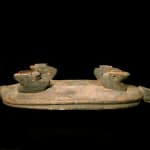Wood Stool Featuring Crocodile Heads, 1850 CE - 1920 CE
Wood
8 x 22
DE.037 (LSO)
This striking crocodile-headed stool was made by the Sepik River group of Papua New Guinea. It is a dished oval surface with an exterior groove running around the circumference. It...
This striking crocodile-headed stool was made by the Sepik River group of Papua New Guinea. It is a dished oval surface with an exterior groove running around the circumference. It is supported on four flexed animal legs, and the handle at each end of the piece is carved into the likeness of a crocodile head. The heads are expertly rendered, with a domed midsection bearing the eyes, a pointed snout and an exaggeratedly long double row of teeth in each of the slightly open mouths.
The Sepik people are renowned for their material culture, which ranges from ornate shields to weapons, canoe prows and everyday items such as this. Like African cultures – and indeed much of the rest of the world – stools and chairs are intimately associated with high status, and it is therefore probable that this once belonged to a chief or someone of similar social importance. Crocodiles were also associated with high status individuals, and were believed to be a marker of benediction: thus they were often used as prows on canoes in order to assure their success in battle or exploration. Aboriginal populations also believe them to have magical powers, especially in regards to fortune telling and the casting of curses.
This is a powerful and well-carved piece of Sepik material culture that is a work of art in the complexity and sophistication of its execution.
The Sepik people are renowned for their material culture, which ranges from ornate shields to weapons, canoe prows and everyday items such as this. Like African cultures – and indeed much of the rest of the world – stools and chairs are intimately associated with high status, and it is therefore probable that this once belonged to a chief or someone of similar social importance. Crocodiles were also associated with high status individuals, and were believed to be a marker of benediction: thus they were often used as prows on canoes in order to assure their success in battle or exploration. Aboriginal populations also believe them to have magical powers, especially in regards to fortune telling and the casting of curses.
This is a powerful and well-carved piece of Sepik material culture that is a work of art in the complexity and sophistication of its execution.



